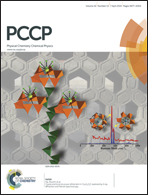Intermolecular charge transfer enhances two-photon absorption in yellow fluorescent protein†
Abstract
We present a quantum chemical study of the two-photon absorption (TPA) properties of yellow fluorescent protein (YFP), a mutant of the extensively studied green fluorescent protein. The aromatic chromophore of YFP has a π-stacking interaction with the aromatic ring of a tyrosine residue (Tyr203) in a parallel-displaced structure with a distance of about 3.4 Å. We study the TPA spectrum of the π-stacking system of YFP using the well-established Coulomb-attenuated B3LYP density functional (CAM-B3LYP) and the second-order approximate coupled-cluster model CC2. This work presents both the first comprehensive study of the two-photon absorption spectrum of YFP and the largest-scale coupled-cluster calculation of two-photon absorption that has ever been performed. We analyze the intermolecular charge-transfer (ICT) transitions in this stacked system and show that the ICT transitions are an important mechanism for enhancing the TPA cross sections in YFP. We investigate the distance dependence of the ICT transitions and show that their TPA cross sections are strongly dependent on the separation of the aromatic moieties. This provides a means for tuning the TPA properties of YFP and other structurally related fluorescent proteins through molecular engineering.


 Please wait while we load your content...
Please wait while we load your content...